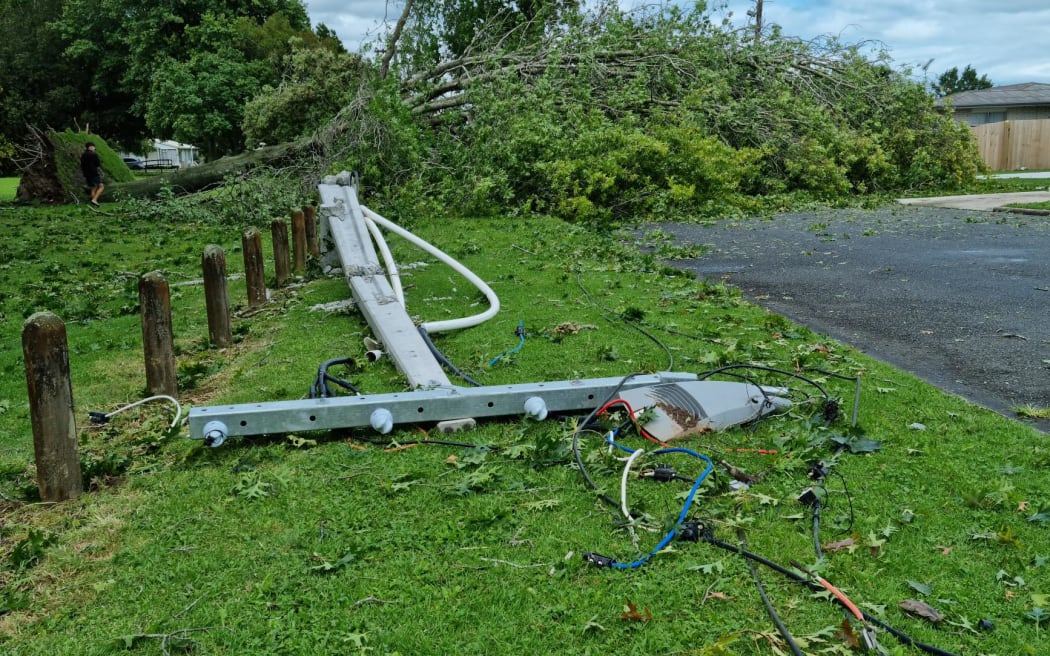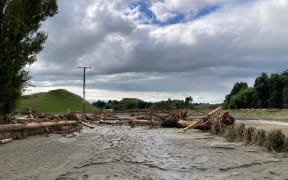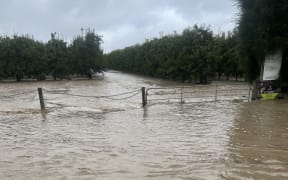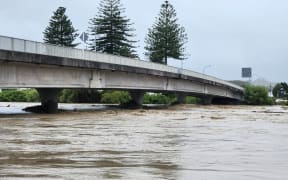By Ulrich Speidel, University of Auckland senior lecturer*

Power lines down in Scott St, Leamington, Cambridge, Waikato on 14 February. Photo: RNZ / Libby Kirkby-McLeod
There are limited communications out of areas severely affected by Cyclone Gabrielle in the central North Island.
Cell phone tower and electricity network outages in places like Hawke's Bay and Tairāwhiti have meant hundreds of people have been uncontactable and authorities also had their contact with support and emergency services disrupted.
Although some communication and power is being restored, there are still challenges around bandwidth, signal strength, and charging devices.
Here are a few tips for civilians in affected areas on getting around these problems.
Fixed line internet
If you are on an ADSL or VDSL connection (via your phone line) and the power in your area or a neighbouring street is out: These often run out of street-side cabinets that use the same mains power as the properties in the street.
When power to the cabinet goes off, a battery-based uninterruptible power supply in the cabinet will take over - for something like 24 to 48 hours. Once this is exhausted, your DSL connection will go down as well. Use it before it dies.
Mobile data / text / calls
Mobile data is an alternative to fixed line Internet but not available with sufficient capacity everywhere. In an emergency, stick to text and voice calls as much as possible, also text-based messenger apps, to conserve battery power both for your phone and for the cell sites. Minimise use of video calling. It's also not a good time to hunker down with Netflix, TikTok, YouTube, Vimeo, or any other video-based application.
When using your mobile, try to go to a place where you get a good signal: Outside, ideally within direct view of the cell site, as close to the cell site as possible (if you know where it is and of course if it is safe to do so). The fewer walls, windows and obstacles, the better. Coarse rule of thumb: halving the distance to the cell site means using one quarter of the power, so your battery lasts a lot longer. Keep communications short.
Turn mobile phones off that aren't needed: If the entire whānau are together, work out who really needs to operate their phone and who doesn't. Phones "talk" to cell sites even if they are not actively calling / texting / surfing and this also drains batteries at both ends.
Consider using SIM cards from two providers in a dual-SIM phone: If one network can't provide coverage, another might.
Wireless / Satellite internet
There are a number of providers in New Zealand offering such services, e.g.: Gravity (getgravity.nz, satellite), Woi (woi.co.nz, satellite), Uber NZ (uber.nz, terrestrial wireless, nothing to do with the taxi company), Wireless Nation (wirelessnation.co.nz, terrestrial wireless), Farmside (farmside.co.nz, terrestrial wireless) and others.
If your usual provider is not able to help where you are, they may be able to. Expect them to be crazy busy right now, though.
Starlink
This is a satellite service available across NZ (starlink.com) based on an up-front hardware cost and a monthly subscription. It is relatively easy to set up compared to other satellite services and mostly plug and play, giving you a WiFi router as part of the package. You need a spot with a relatively clear view of the southern sky or it will not work all that well.
There are also limits to the number of users Starlink can support in a given area and in some areas in New Zealand, this limit has been reached and Starlink will defer orders from those areas until more capacity is available (starlink.com has an availability map).
Comparable in performance to a good ADSL/VDSL connection and sometimes better than that, depending on where you are and how many other users there are in your area. It will take a generator or mains power to run - it consumes about 100W at peak.
*Dr Ulrich Speidel is a senior lecturer in computer science at the University of Auckland with research interests in fundamental and applied problems in data communications, information theory, signal processing and information measurement.
National Emergency Management Agency advice:
- Put safety first. Don't take any chances. Act quickly if you see rising water. Floods and flash floods can happen quickly. If you see rising water do not wait for official warnings. Head for higher ground and stay away from floodwater.
- Do not try to walk, play, swim, or drive in floodwater: even water just 15 centimetres deep can sweep you off your feet, and half a metre of water will carry away most vehicles.
- If you have evacuated, please stay where you are until you are given the all-clear to go home.
- If you don't need to evacuate, support those who do by staying home, staying off roads and staying safe.
- If you are not able to contact your whānau in the heavily affected areas go to Police 105 website and complete the inquiry form or phone 105 and remember to update if you reconnect through other means.
- Throw away food and drinking water that has come into contact with floodwater as it is often contaminated and can make you sick.
- If you are without power eat the food from your fridge first, then your freezer. Then eat the food in the cupboard or your emergency kit.
- People should stay up to date with the forecasts from MetService and continue to follow the advice of civil defence and emergency services.
- A National State of Emergency is in place for an initial period of seven days and applies to regions that have declared a local State of Emergency.





